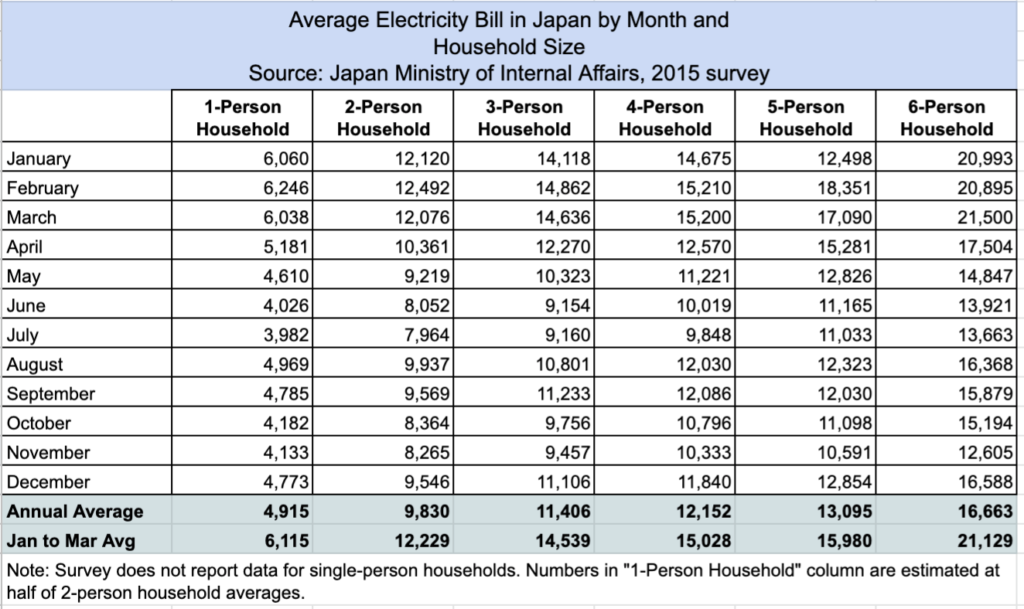In this article, we cover the average electricity bill in Japan by month and household size. And go over a few tips for how to lower your winter electricity bill. This article is part of the series on “how to live in a Japanese apartment“.
What is the average electricity bill in Japan?
Below are national annual average household electricity bills broken down by number of people per household, and for the winter months (January to March). The data was calculated based on data from Japan’s Ministry of Internal Affair’s 2015 survey on household spending. Note that the ministry does not report data for single-person households, so we’re estimating these numbers as half of the two-person household average.
- One-person household: ¥4,915 annually, ¥6,114 in winter
- Two-person household: ¥9,830 annually, ¥12,229 in winter
- Three-person household: ¥ 11,406 annually, ¥14,439 in winter
- Four-person household: ¥ 12,152 annually, ¥15,028 in winter
- Five-person household: ¥13,095 annually, ¥15,980 in winter
- Six-person household: ¥16,663 annually, ¥21,129 in winter
Do electricity bills tend to peak in winter?
Yes. Nationally, electricity bills peak from January to March. Please see the breakdown in the table below.

Tips for Cutting Your Winter Electricity Bill
#1 Think ahead, way ahead
Insulation in older apartment buildings in Japan tends not to be very good. Wait. Let’s restate that. Insulation, even in some newer apartment buildings, tends not to be very good; but certainly in older buildings the problem is worse.
And very often you get what you pay for. When you are apartment hunting and find a bargain room in an older building or a great deal on an older single-family house for rent, know that one reason these properties are less expensive is because the quality of construction materials is much lower.
Wooden apartment buildings tend not to be as well insulated; neither are wooden older single-family homes. In the winter, you may literally feel the wind blowing through cracks in the walls and windows. You may save on monthly rent if you rent a property like this, but you’ll pay more to keep your home warm in the winter months.
Higher-grade properties, of course, cost more to rent, but higher rent tends to reflect the benefits of convenient location, newer construction, and quality of building materials and amenities. Higher floors in mid- and high-rise apartment buildings tend to be warmer than lower floors. And condominium buildings constructed of reinforced or steel-reinforced concrete are better insulated than wooden apartment buildings.
A nice winter amenity is underfloor heating.which is a heating system that generates radiant heat using sub-floor hot water pipes, warm air ducts, or electrically heated wires. This type of heating system is very energy efficient compared to a wall-mounted A/C unit. Underfloor heating by itself may not be a reason to choose an apartment, but if you have it, you’ll find that you won’t have to overuse your other heating sources to stay warm. This is a feature usually found in high-grade buildings.
On Real Estate Japan, if a property features this amenity, you can find it listed as a “Feature” in the property description.
#2 Find the most energy-efficient heating source for how you live
If you are a single-person or two-person household, except for when you’re outside, you could spend a perfectly happy winter camped out in front of your kerosine heater or kotatsu. You may occasionally want to take a bathroom or kitchen break, of course, but really no need sleep in the bedroom when the living room will do. Basically, only heat the spaces that you really need to keep warm. At least that’s what we’re told by our friends up in Hokkaido.
Please see this article for a comparison of the energy efficiency of various heating sources: 8 ways to heat your home in Japan
#3 DIY Insulation and Other Simple Hacks
These articles have many other tips for how to stay warm in winter: How to stay warm at home in Japan and Using the air conditioner remote in a Japanese apartment
Including:
- DIY insulate your windows and entryway (genkan) with plastic sheets and bubble wrap
- Regularly clean the filter in your wall-mounted A/C and the exterior unit (located on the balcony) to keep it running efficiently
- Point the vents downward on your A/C unit (because hot air rises)
- For every 1 degree Celsius that you decrease the thermostat in the winter, you will save about 10% in electricity usage; and vice versa in the summer.
- Cook things that warm up your home, like a big pot of soup or nabe (hot pot)

Lead photo: By author id:takefumi via Wikimedia Commons, taken February 7, 2004